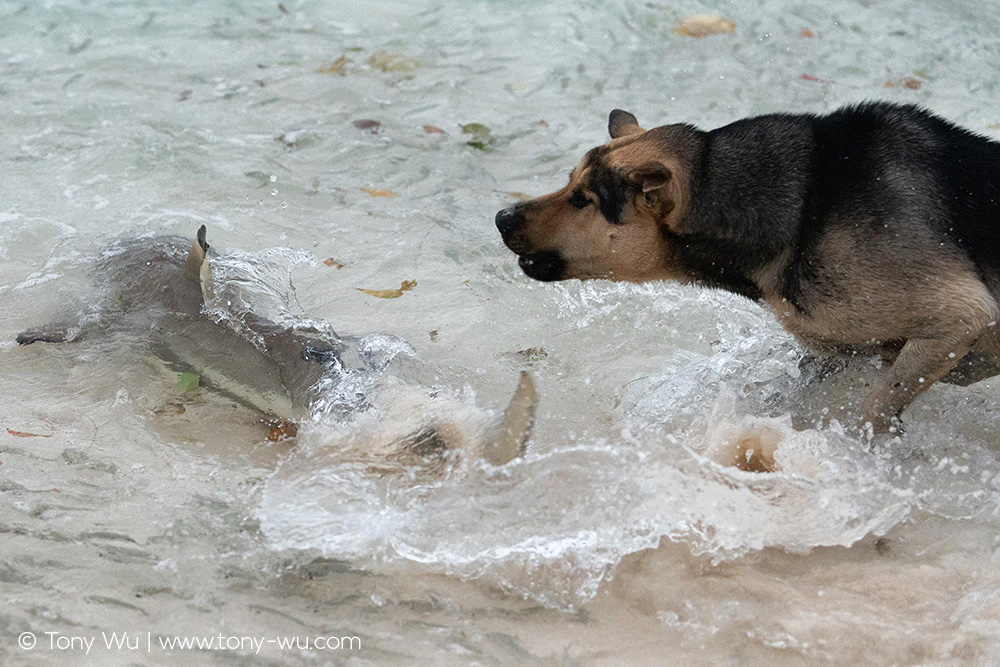Happy new year!
I hope you had a terrific holiday season.
For this first newsletter of 2019, I’d like to share a story with you. It is a true story, a chain of events and thoughts that typifies what I do with my time.
To whet your appetite in a shameless attempt to get you to think, “Hmmm, maybe I should persevere and actually read this rambling nonsense of Tony’s,” I will jump straight to the punchline with this photo:
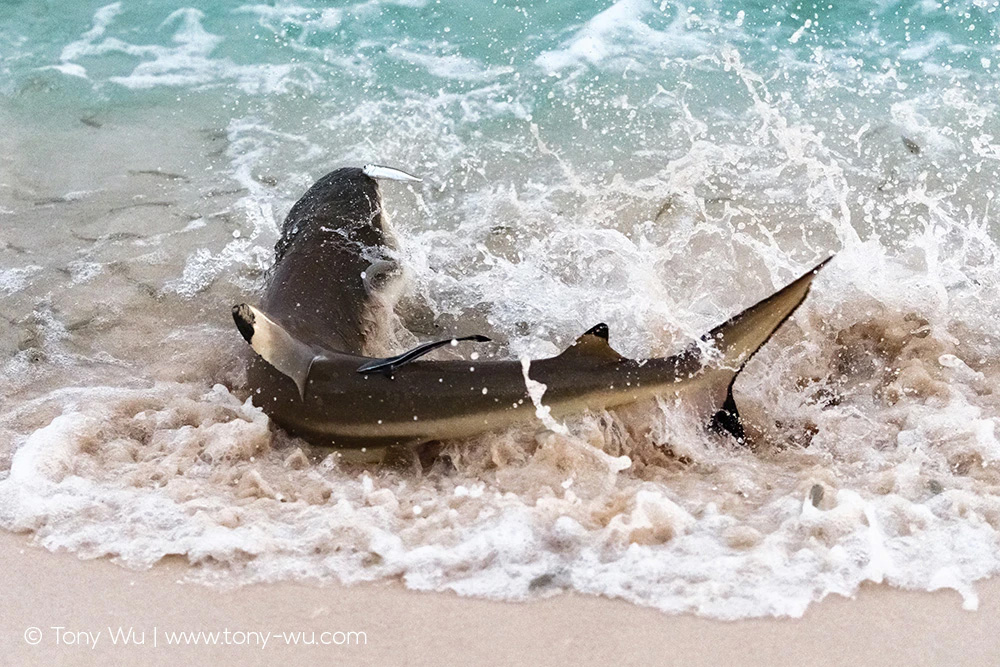
It is a blacktip reef shark (Carcharhinus melanopterus) beaching itself in order to catch sardines. I don’t know about you, but for me, that’s turning the volume up to 11 in a major way.
Let’s back up a bit. Let me tell you how I got to that photo, after this quick message from our sponsor (that's me):
Meet Some Humpback Whales!
If you'd like to meet some humpback whales and listen to me ramble about their biology, behavior, and some of the fascinating, as-yet unexplained things I've observed over the past 20+ years, I am working out details now for these dates: 3-14 September 2019; 16-27 September 2019. Please message me if you're interested. Here is my 2018 summary of my time with humpback whales for some background.
Back to the story...
It all started with a boat ride to a small island, as many memorable experiences in my life have.
I was due to rendezvous with friends and had arrived a few hours early. One thing led to another, and I found myself staring at birds, brown boobies to be exact, Sula leucogaster.
It was mid-day, tropical sun beating down on white sand, seas of sapphire blue cresting onto shore from time to time. “Plunk-boom!” a booby plunged beak-first from a height of 10m or more (that’s about 33ft for the metric-measurement-challenged) into the water.
When it popped up like an overeager cork seconds later, there was a sardine in its beak. A fish who, at that very moment, probably thought there were any number of other places that were far more ideal for it to be. As if to confirm the fish’s astute observation, the booby swallowed it. Whole.
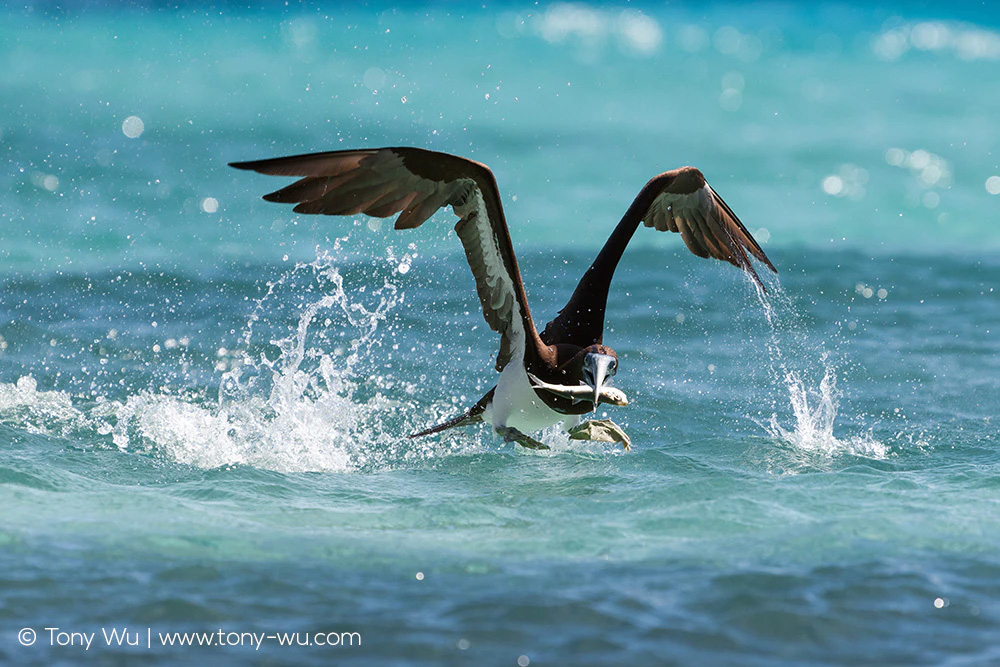
Clearly pleased, the bird preened, fussed, looked around, then took to the air.
By this point, you could say that I had become entangled like a quantum particle with the booby. As it headed skyward, I raced across the beach (more accurately—fumbled in the awkward manner characteristic of all bipedal sprints across soft white sand). As the bird circled back to the sardines, I too scrambled back toward the action, camera in hand.
(Picture the following in super slo-mo for dramatic, but hopefully not cheesy, effect.)
High above, with keenest of sight and clarity of purpose, the bird took aim. Wings tucked in, the booby yielded to gravity and plummeted for the attack—a plumaged pike of piscine destiny.
Running as hard as I could (cue Chariots of Fire theme song), I slide into the sand like a runner stealing home plate.
Downward the booby; upward my camera.
What a spectacular shot this would be!
There I was, kneeling at the end of extended skid marks on the beach, concentrating through the viewfinder at—nothing.
At the last moment, the booby had veered. Gone back up.
To the casual observer (of which there fortunately only a few who were pretending I didn’t exist), what had transpired could possibly have been interpreted as a bird outwitting a would-be photographer, though in my defense, I would argue that a more inclusive explanation for the events that had unfolded would require a full accounting of the stratagems of the fish, which had likely launched defensive countermeasures to foil their avian antagonist's best-laid plans.
Anyway, that was the beginning of an obsession that lasted for nearly two weeks.
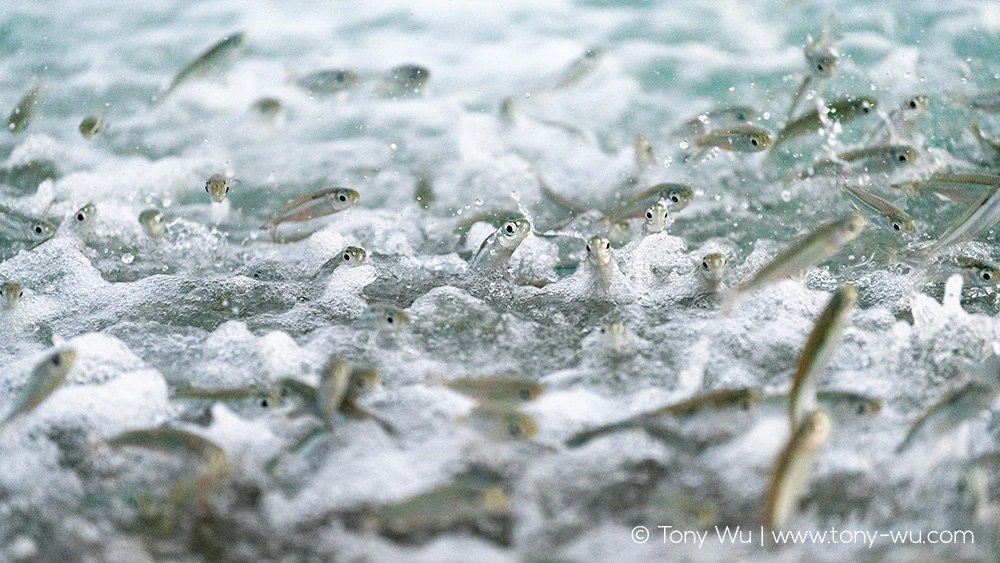
See the fish in the middle pleading for help?
Within short order, I worked out that peak hunting action was in the early morning, usually during the half-hour approaching sunrise.
That was when several species converged for a full-on assault.
In the water were at least three predators—trevallies, some sort of elongated fish (perhaps a longtom species), and blacktip reef sharks. It is of course entirely possible that there were other marine predators involved that I did not see.
Aerial woe visited the beleaguered sardines in the form of the aforementioned brown boobies and also greater crested terns (Thalasseus bergii - thank you Noina for the avian ID assist!), with secondary, indirect predation by lesser frigatebirds (Fregata aerial), which harassed terns and stole fish from them.
And here is where the story gets really interesting.
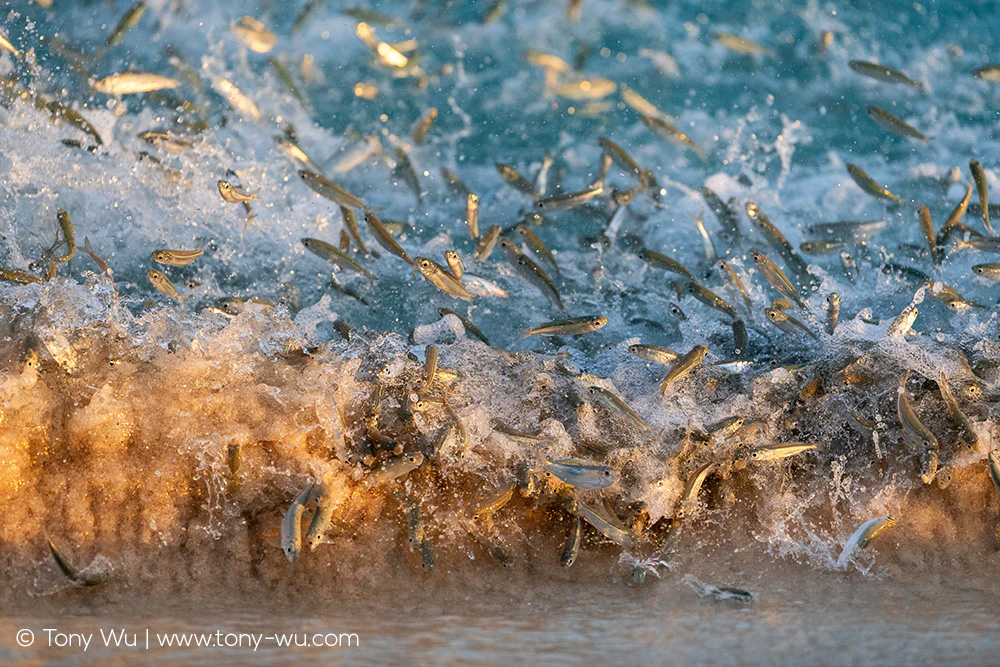
In the first few days, it was all I could do to try to be at the right place at the right time to take photos.
The beach was long, which meant the action could in some cases be spread out, and most often happened exactly where I was not. Sometimes, it was difficult to get to the action simply because running on sand (with embedded rocks, corals, shells and other ouch-ouch-boo-boo things) is not easy.
Given the time of day, light levels were low. Clouds on the horizon often blocked the sun. Using high shutter speeds for rapidly moving subjects while running with a telephoto lens in dark conditions is not ideal, to say the least.
I also had to scarf down breakfast during the same window of opportunity, as we headed out each day soon after sunrise. (Can you see me charging toward the beach with a mouthful of food? It happened more than once.)
In the beginning, no one else seemed to care or pay attention. But once other people became interested enough to stand on the beach, smartphones in hand, I had to navigate an obstacle course as well.
And finally, there were the dogs. I loved the resident dogs, and they loved me. Actually, perhaps they loved that there was finally(!) an enlightened(?) human who was engaging in worthwhile activity. You know—running around, chasing fish and the occasional coconut, jumping up and down, sliding into the wet sand, making a mess. The problem was that they liked me so much that they wanted to help me, which most often meant charging straight into photos I was trying to take. All I could do was plead, “No!” which undoubtedly translated in doggy language as, “Yeah yeah yeah! So, obviously, absolutely, without-a-doubt, insanely YES!!!!!”
Once I figured out ways to deal with the chaos, my mind started asking questions. Why was the timing what it was? What was the connection among the predator species? Was it chance? Or was there a method to the pandemonium?
Over time, I figured it out.
The attacks were in fact not random, nor was the relationship among the predators. There was a clear logic to it. (See? Despite all indications to the contrary, I do have a coherent point to convey.)
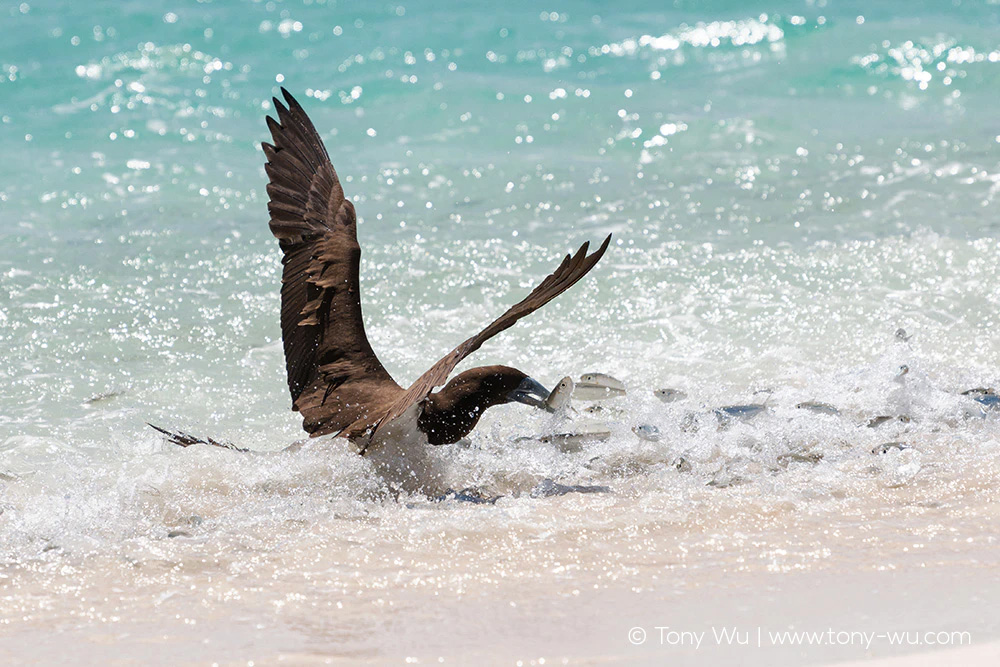
Every attack began with the set-up.
A group of trevallies—somewhere between five and fifteen—patrolled the perimeter, working as a unit to herd the baitfish toward shore. Individual blacktips patrolled in shallow water, loners who in contrast to the trevallies demonstrated no coordination whatsoever. If anything, their movements seemed to disrupt the work of the trevallies. There were between three and five sharks on any given day. The longtoms I couldn’t see well. They appeared occasionally near the trevallies. That could simply have been coincidence, or perhaps they were in some way coordinating with the bigger fish.
In the air, boobies circled and terns waited. It was clear that the terns were the more eager of the two species during this time. Later, I would deduce a likely reason—namely, boobies can take sardines easily, any time they want. Terns, being much smaller, aren’t as well equipped to dive+ambush sardines, which are large relative to the size of the terns. Finally, there were the frigates, which usually hovered higher, at least until the action commenced.
Each predator had a niche, a role.
The trevallies herded, but more importantly, they initiated the attacks. When the trevallies decided en masse to slice through the huddled sardines, grabbing prey and sending the baitfish into all-out, swim-for-your-life panic, they effectively gave the “Go, go, go!” signal to everyone else.
Longtoms then cut through the water, often breaching full body several times in a row, grabbing hapless sardines along the way. Swimming just beneath the surface as these elongated fish do, the longtoms operated in somewhat deeper areas away from the surf line, taking fish near the surface.
Then came the blacktips. As the sardines panicked, many broke off into smaller groups. When groups were pushed or moved voluntarily into shallow water, blacktips charged in, creating a wave of panic that led to fish jumping into the air and sometimes onto the beach. Sharks pursued, beaching themselves, picking fish off the sand and from extremely shallow water as waters receded.
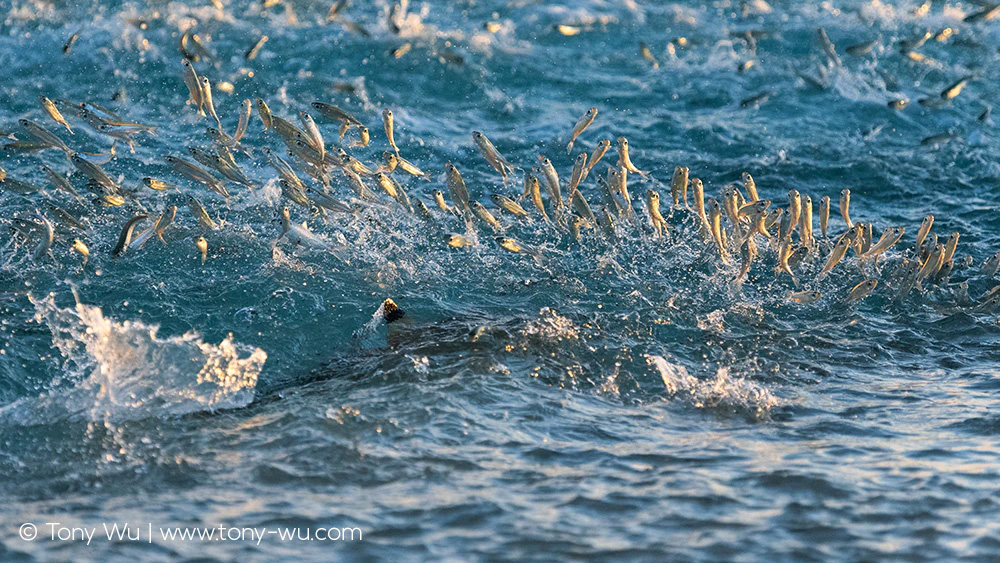
Predator below. Flying fish above.
And then there were the birds.
Boobies were pretty much free agents, taking advantage of the bedlam, plucking fish from the water or shore as and when they pleased.
The terns though, the terns loved it. Having distressed and discombobulated fish out of water was a treat for them. The inability of the sardines to swim gave the terns the advantage they needed to secure what for them is large, unwieldy prey. Terns swooped down, grabbed stranded sardines, swallowed them whole when possible, carried them away to consume in stages when necessary.
One interesting thing I noted was that even with the surfeit of prey, terns often fought with each other over a single fish instead of just taking a different one. Humans, of course, are far too intelligent and evolved to do anything similar. Right?
When terns took flight with sardines in beak, frigatebirds often swept down, harassing and haranguing the terns until the little birds dropped their intended meals.
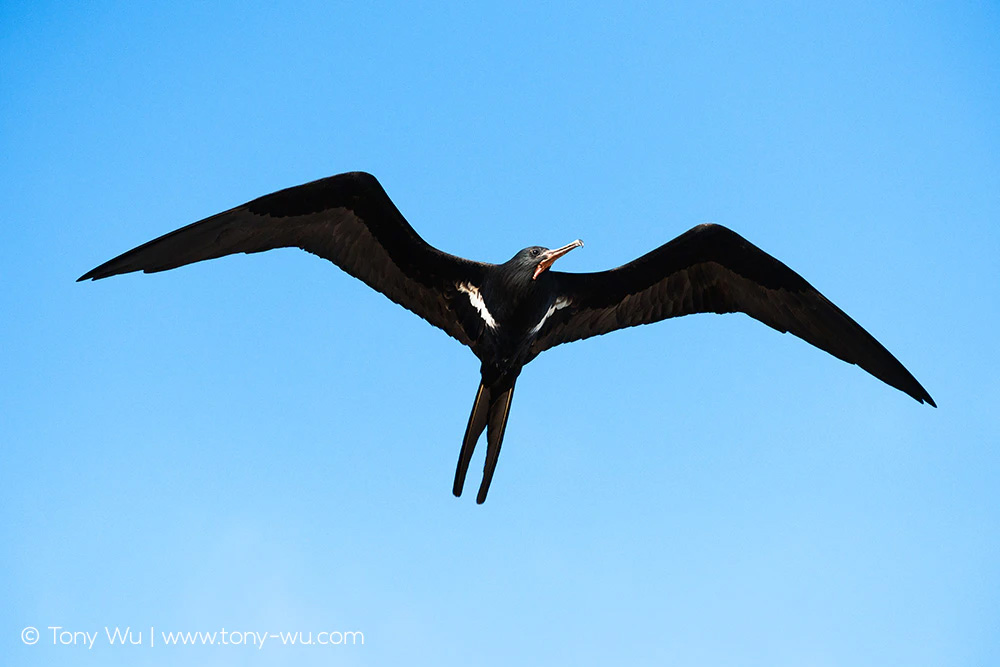
This spectacle went on every morning for nearly two weeks. Some days lots of action, other days, not so much. Then it all came to an abrupt end, at least for the balance of my temporary residence at the island, after a couple of the trevallies were killed with a speargun. They sort of lost their mojo after that.
Without the “Let’s Chow!” signal from the band of trevallies, there was little to no action. The players still gathered, but almost nothing happened, underscoring how interconnected the participating species were.
The reason I am sharing this experience with you is that it illustrates what I mean by the term photo-naturalist, which is what I call myself.
With so much simultaneous and chaotic action taking place, it was nearly impossible to make sense of who, what, why, when and where. Until I figured out the game plan.
Once I saw which predator was responsible for which action, discerned the relationships among the predators, and worked out the roles each played, it became possible to foresee likely events and target specific images. With such a maelstrom of activity, the probability of photographic failure was still high, but figuring out what was going on gave me a fighting chance.
In other words, capturing meaningful images of natural subjects (and everything else, actually) requires knowledge and understanding.
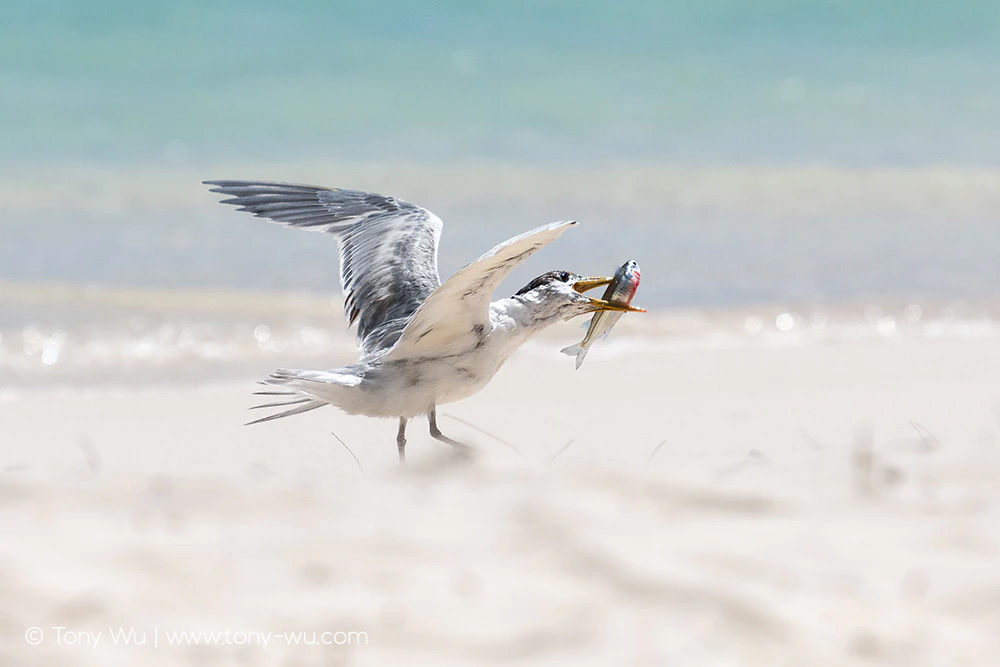
I wasn’t there to photograph this phenomenon. Heck, I didn’t even know this happened, so my equipment was not ideal for the situation. But nature gifted me the opportunity to witness and appreciate this spectacle.
From a life-perspective point of view, it would’ve been a waste not to get up early and chase fish each morning with the predators (and my doggy friends).
From an educational point of view, I learned a lot about the behaviour and characteristics of individuals species, and also of how they worked together.
From a photographic point of view, observing with an eye and mind for detail, bringing to bear everything I had learned about wildlife behaviour to that point, and applying rational thought were the keys to capturing images of a situation that I may never come across again. Plus, it was just lots of fun!
Bottom line: Approaching travel and photography with the mind of a photo-naturalist is so much more rewarding than just wanting to take pretty pictures.
Give it a try. Discover stuff. Make doggy friends at the beach.
ars gratia scientiae
